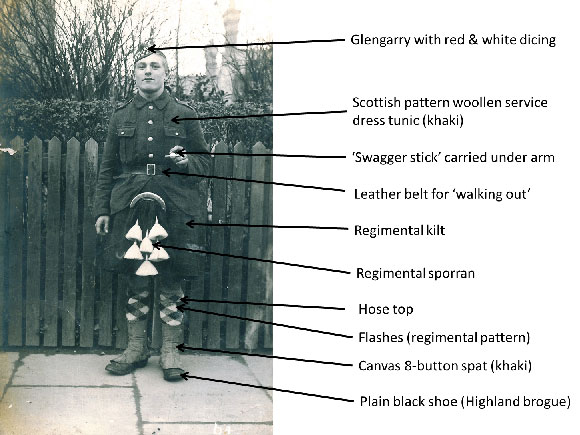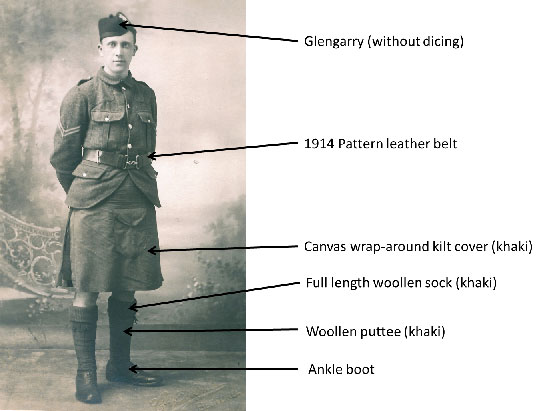Bedford Highlanders
The Uniform
Places > Bedford > First World War > Regiments | Bedford Highlanders Home

In this photograph taken in Bedford in February 1915,
Private Neil Caldwell, 6th Argyll and Sutherland
Highlanders presents the typical image of a Highland
Division soldier of the period.
He wears the
traditional Scottish side hat, called a Glengarry, which
is adorned with a red and white checked band (dicing) in
a pattern particular to his regiment. Each regiment
sported its own variation of dicing and these
differences occasionally even filtered down to battalion
level, most notably the 5th Seaforth Highlanders whose
uniform differed markedly from the other Seaforth
battalions.
Caldwell wears his regimental sporran,
but in Bedford these were usually only worn on certain
occasions, such as Church Parade, inspections or when
having ones photo taken. For everyday wear, the kilt
would usually be worn without the sporran and would very
often be covered with either a canvas kilt cover, or
apron.
Tartan trews (trousers) may sometimes have
been worn instead of the kilt and when off-duty, in
billets, the men would generally wear standard army
issue khaki service dress trousers.
Hose tops were a
half-sock worn from just below the knee to mid-shin.
These were diced in two colours particular to the
regiment. The Argylls wore red and white, as did the
Seaforth Highlanders with the exception of the 5th
Seaforth who wore red and bottle green. The Gordon
Highlanders and Black Watch wore red and black, the
Cameron Highlanders red and bottle green.
An ordinary
woollen sock would be worn on the foot and the join
between this and the hose top would be covered by the
canvas spat. The spat also covered the join between the
shoe and the foot, thus helping to prevent stones and
debris from getting inside the shoe.
(photo: courtesy
of Richard Galley)

This studio portrait of an unnamed corporal in the Royal
Highlanders ('Black Watch') was taken in April 1915 by
C. A. Solomons, Bedford. The man belongs to one of the
two Territorial battalions of the Black Watch which had
been sent to Bedford to reinforce the Highland Division
shortly before it left for France in early May 1915.
Like Private Caldwell, the corporal is wearing the
Scottish pattern service dress tunic which has its front
skirts cut away to prevent them being fouled by the
sporran when it’s worn. This man is wearing a full wrap
around kilt cover which was made of khaki-dyed canvas.
The kilt cover provided a modicum of camouflage and also
helped to protect the heavy woollen regimental kilt,
which was worn underneath, from everyday wear and tear.
Spats and shoes have been replaced by ankle boots
and woollen puttees worn over full length woollen khaki
socks. By this stage of the war lessons learned in the
harsh conditions of the front line had started to filter
through to units waiting their turn to join the
fighting. In the first winter of the war, kilted units
living in the thick, cloying mud of the front line were
quick to realise the woeful inadequacy of shoes and
spats which were all too prone to being pulled off the
foot. Ankle boots were far more secure and the puttees
wound from boot-top to upper shin helped to seal the
join between the boot and the leg, whilst providing an
additional layer of insulation. The full length khaki
wool sock was more practical in the field than the
previous two-piece arrangement of ankle sock and
brightly coloured hose top. It was also more economical
and easier to produce.
(photo: courtesy of Richard
Galley)
Page last updated: 30th May 2014
